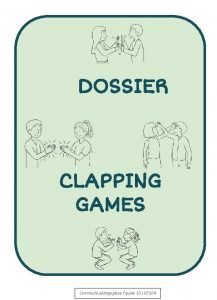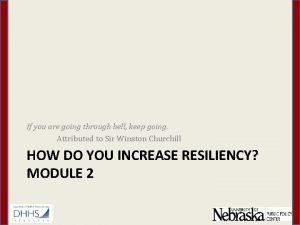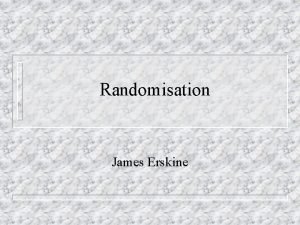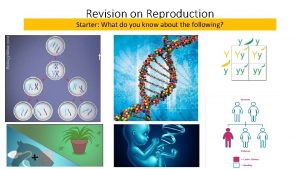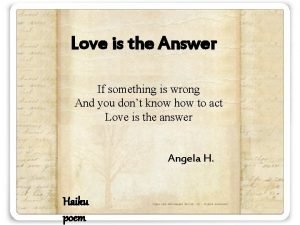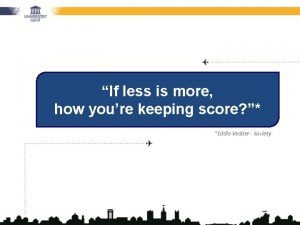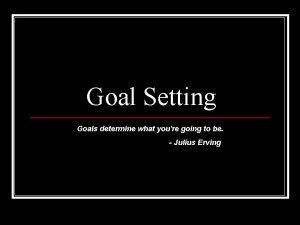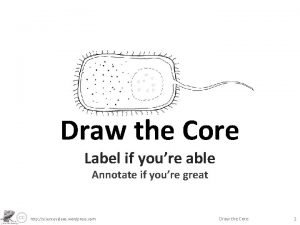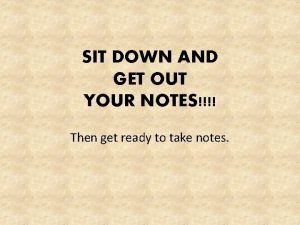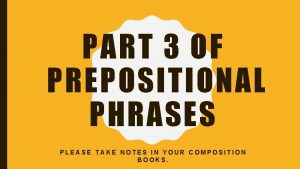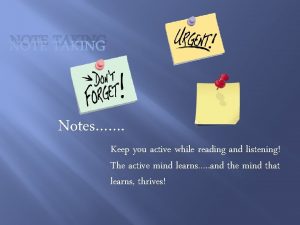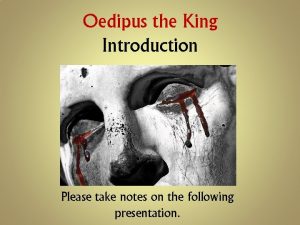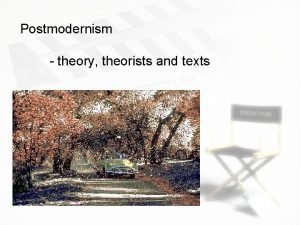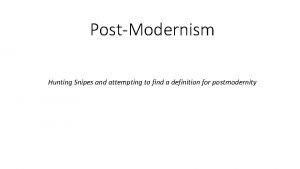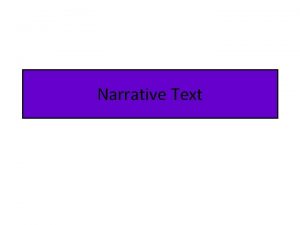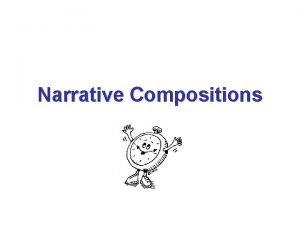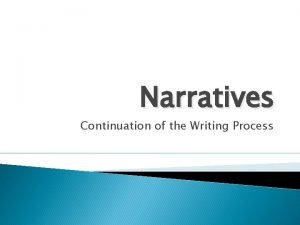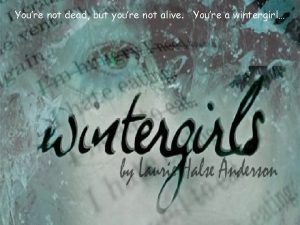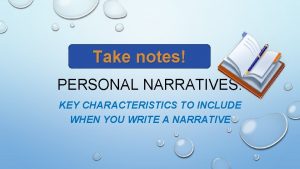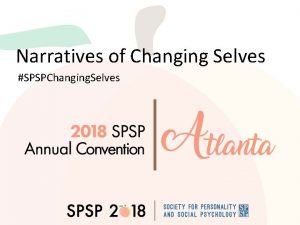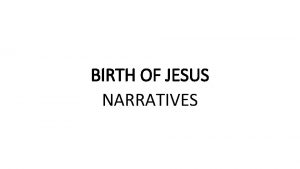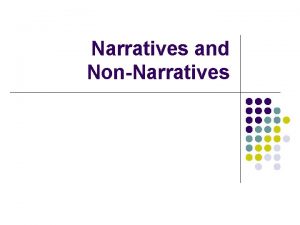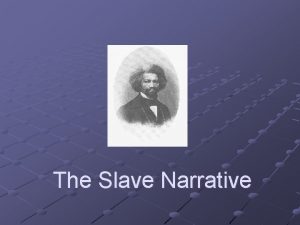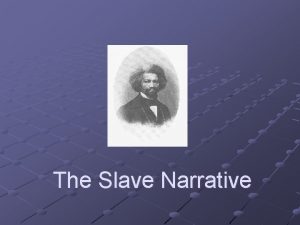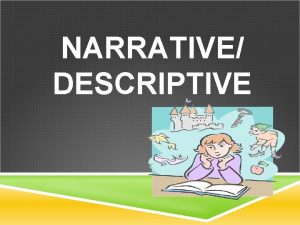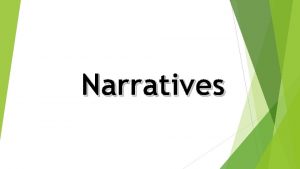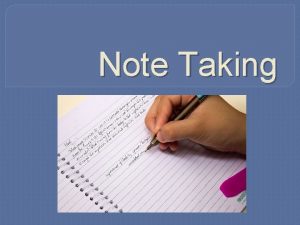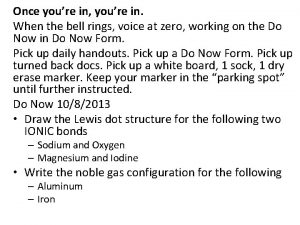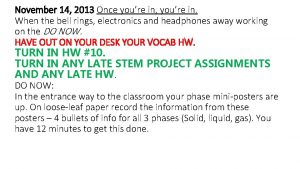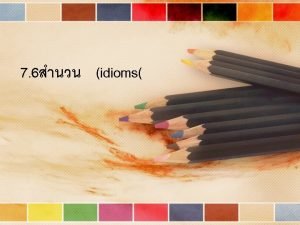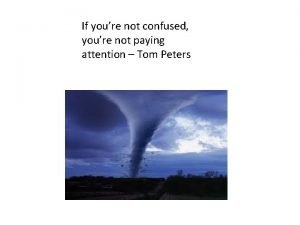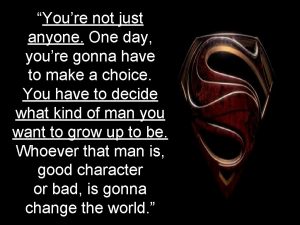Narratives Narratives Youre going to take notes Set



























- Slides: 27

Narratives

Narratives You’re going to take notes! Set them up in two columns: Lit term: Definition: Narrative Plot

A narrative is. . . l l l A story that is told, usually in great detail. It can be fiction (made up) or non-fiction (true) It can be prose, poetry, song, even dance

Plot l The sequence of events in a literary work (the events that happen in a story) Climax Rising action Exposition Falling action Resolution

Plot Parts: l l l Exposition introduces the characters and setting Rising action - the action leading up to the climax of the story (includes conflicts) Climax - the turning point in the story (point of highest interest) l l Falling Action - the action following the climax, leading up to the resolution (conflicts starting to become resolved) Resolution - the ending of the story in which the conflicts are resolved (also called the denouement)

Character: A person/animal/ etc. who takes part in the action of a literary work. 4 Round characters 4 Dynamic characters Are complex and show many qualities, both Develop, change, and positive and negative learn something 4 Flat characters throughout a story Are one dimensional— 4 Static characters they have only a Remain the same single trait from start to finish

Characterization the act of creating and developing a character • Direct The author directly states a character’s traits--The author tells what a character looks like, or what his or her personality is like Example: “She was one of those pretty, charming young women” • • Indirect • • • The author tells how other characters react to him/her The reader determines character traits based on what the character says or how he/she acts Example: “Whenever he [Rainsford] looked up from his plate he found the general studying him, appraising him narrowly”

Types of Characters 4 Protagonist: The main character in a story, novel, drama, or other literary work; the character that the reader or audience empathizes with. This is usually “the good guy. ” In complex works of literature, it may not be as obvious. In the Game of Thrones series, Jamie Lannister initially appears to be an antagonist. As the series progresses, though, he takes on the characteristics of a protagonist. Similarly, a character like Deadpool is not always “good, ” but is definitely the protagonist of the story.

Character types, cont’d 4 Antagonist The character who opposes/provides conflict for the protagonist. The antagonist, when there is one, provides the story's conflict. The antagonist does not always have to be a “bad” person. Think about Snape in Harry Potter. Yikes. Is he REALLY a “bad guy”?

Theme 4 Theme – central message or insight into life revealed through the story; the “lesson” the author wants you to learn 4 A theme is a SENTENCE, never just a word or a phrase: 4 A theme in The Hunger Games is that sometimes people are forced to do terrible, awful things that haunt them forever, just so they can survive.

While not all stories have one, in this class, it’s all about theme!

• • • Setting – time and place Tone – the attitude the author has toward the subject, etc. Dialogue – what is being said by the characters

Irony 4 Situational – the actual outcome of a situation is the opposite of what is expected 4 Ex: “A local man died when he was accidentally run over by an ambulance. ” 4 Verbal – when a person says one thing and means another 4 Ex: “Cool shirt. ” : : eye roll: : Sarcasm! 4 Dramatic – when the reader knows something that a character does not know 4 Ex: The girl goes upstairs, and we know there is a killer waiting there.

Point of View speaker or character who tells the story • First person • A character in the story tells the story • Uses I, me, we, us • Third person • Voice outside the story tells the story • Omniscient (all knowing) • Limited • Uses he, she, it, them, they

Conflict a struggle between opposing forces • External – main character struggles against an outside force • Human vs. human • Human vs. nature • Human vs. society

Conflict a struggle between opposing forces • Internal – main character struggles against himself/herself • Human vs. self

Figurative Language 4 Language used for descriptive effect, often to imply ideas indirectly. Often express an idea beyond the literal level: – Denotation – Connotation – Imagery – Simile – Metaphor – Symbolism


Figurative Language, cont’d 4 Denotation: The literal meaning of a text 4 Connotation: the figurative meaning of a text

Connotation –vs- denotation practice I thought if I could touch this place or feel it this brokenness inside me might start healing. Out here it’s like I'm someone else, I thought that maybe I could find myself If I could just come in I swear I'll leave. Won't take nothing but a memory From the house that built me. What is the denotation of these lyrics? What is the connotation of these lyrics?

Figurative Language, cont’d Imagery: descriptive language that appeals to the senses "The Radley place jutted into a sharp curve beyond our house. Walking south, one faced its porch; the sidewalk turned and ran beside the lot. The house was low, was once white with a deep front porch and green shutters, but had long ago darkened to the color of the slate-grey yard around it. Rain rotted shingles drooped over the eaves of the veranda; oak trees kept the sun away. The remains of a picket drunkenly guarded the front yard-a ‘swept’ yard that was never swept-where Johnson grass and rabbittobacco grew in abundance" (8).

Stop it. No I don’t think you’re going to love this; it’s just more interesting than me talking at you. In case the video doesn't work

Figurative language, cont’d Simile: a figure of speech that uses like or as to compare one thing to another Metaphor: compares two things but without using like or as Do you ever feel like a plastic bag, drifting through the wind wanting to start again? Do you ever feel, feel so paper thin like a house of cards, one blow from caving in? Do you ever feel already buried deep? 6 feet under screams but no one seems to hear a thing Do you know that there's still a chance for you 'Cause there's a spark in you You just gotta ignite, the light, and let it shine Just own the night like the 4 th of July 'Cause baby you're a firework Come on, show 'em what you're worth Make 'em go "Oh, oh" As you shoot across the skyy-y Identify and discuss the simile and the metaphor in the lines above.

FINAL example of figurative language… 4 Symbolism (or symbol): an object, a person, or an experience that, although has a literal meaning, represents something else. A symbol may have more than one meaning and can even change meanings within the same work


Examples of symbols… The color white The color red What do you think each picture symbolizes?

Let’s take a figurative language quiz! Some of these answers are types of figurative language that were not listed here, so yay for you if you know them (hyperbole, onomatopoeia, etc…)
 Tic tac toe going high going low going criss cross lollipop
Tic tac toe going high going low going criss cross lollipop I dont know where youre going
I dont know where youre going Total set awareness set consideration set
Total set awareness set consideration set Training set validation set test set
Training set validation set test set If you are going through hell, keep going means
If you are going through hell, keep going means Email writing topics
Email writing topics How to act angry
How to act angry A very good afternoon to everyone
A very good afternoon to everyone My firm foundation
My firm foundation Random compliment generator
Random compliment generator My master my king season 3
My master my king season 3 How to know if youre asexual
How to know if youre asexual Love and hate poem
Love and hate poem If less is more how you keeping score
If less is more how you keeping score Youre goals
Youre goals Use the labels to draw and annotate a cell membrane
Use the labels to draw and annotate a cell membrane And the tree was happy but not really
And the tree was happy but not really Take a bus or take a train
Take a bus or take a train To take notes in spanish
To take notes in spanish Sit down and take notes
Sit down and take notes Please take notes
Please take notes Active note taking
Active note taking Please take notes
Please take notes Postmodernism definition
Postmodernism definition Postmodernism definition
Postmodernism definition Narrative writing purpose
Narrative writing purpose What are narratives?
What are narratives? Oral narratives
Oral narratives
